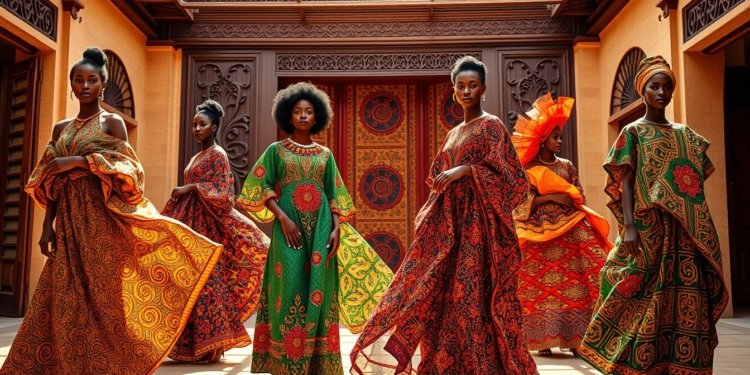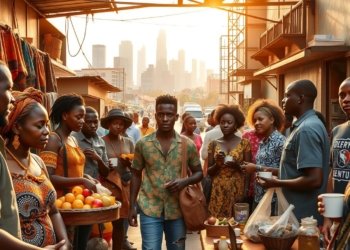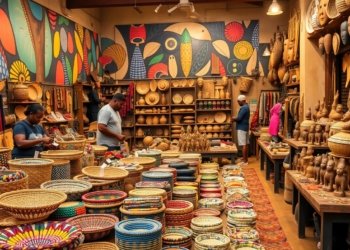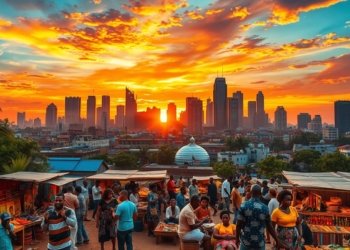What if the next big wave in fashion isn’t coming from Paris or Milan, but from Lagos and Johannesburg? African creativity is reshaping the industry with bold prints, sustainable practices, and a fresh perspective on luxury. The continent’s fashion scene is projected to hit a $32 billion valuation, proving its influence is here to stay.
Designers like Rich Mnisi and Lisa Folawiyo blend Ankara fabrics with modern cuts, while brands such as Corteiz and Subwae push streetwear and sustainability forward. Social media amplifies these voices, turning local heritage into global inspiration.
Key Takeaways
- Africa’s fashion industry could reach $32 billion in value by 2023.
- Traditional techniques like Ankara prints merge with contemporary designs.
- Brands span streetwear, luxury, and eco-conscious segments.
- Social media drives global visibility for African designers.
- Cultural preservation meets innovation in textiles and silhouettes.
The Rise of African Lifestyle Brands
Global runways now spotlight bold Ankara prints and Xhosa beadwork, proving African creativity drives fashion’s future. Designers blend ancestral techniques with cutting-edge silhouettes, creating pieces that resonate worldwide. This movement isn’t just about aesthetics—it’s a celebration of identity and innovation.
How African Heritage Shapes Global Trends
Traditional craftsmanship fuels modern collections. Laduma MaXhosa’s knitwear incorporates Xhosa beadwork, while Finchitua revives Ethiopian Habesha weaves. These designs tell stories of heritage, connecting wearers to centuries-old traditions.
Moshions reimagines Rwandan Imigongo patterns through tailored suits, merging art with apparel. Such techniques preserve culture while appealing to global audiences. Over 78% of these brands use organic or recycled textiles, proving ethics and aesthetics coexist.
The Role of Sustainability in African Fashion
Circular models dominate. Buziga Hill transforms mitumba (secondhand clothing) into premium garments, with 60% of materials upcycled. Subwae partners with local artisans, using eco-safe dyes and biodegradable fabrics.
Tech-enabled supply chains boost efficiency. KotD’s Vienna workshop employs immigrant craftspeople, bridging community and commerce. Meanwhile, Lagos-based Motherlan leverages digital platforms to reach London buyers, proving local talent can thrive globally.
The fashion industry is taking notes. African designers set benchmarks with sustainable fashion practices, from zero-waste production to social-impact partnerships. Their approach isn’t just trendy—it’s transformative.
Luxury Streetwear Brands Making Waves
Streetwear isn’t just a trend—it’s a global movement, and African designers are leading the charge. Blending skate culture, music, and ancestral fabrics, these labels redefine what clothes can represent.
Motherlan: Skate Culture Meets African Creativity
Born in Lagos and now thriving in London, Motherlan merges skate decks with soulful designs. Their Dr. Martens collaboration spotlighted Nigerian artistry, while their videos and music productions celebrate multidisciplinary creativity.
Neoprene blends and bold graphics define their collections. Photographer Tyler Mitchell captures their aesthetic—raw, rebellious, and rooted in heritage.
Corteiz: Guerrilla Marketing and Cultural Rebellion
Corteiz’s Alcatraz logo became a symbol of defiance, worn by Drake and Stormzy. Their £30-125 pricing balances accessibility with exclusivity, driving 300% yearly growth.
Drops sell out in minutes, proving guerrilla tactics—like surprise pop-ups—resonate with Gen Z. Their cargo pants are a uniform for the culturally woke.
Urban Zulu: Spiritual Streetwear with Local Fabrics
Johannesburg’s Urban Zulu weaves spirituality into style. Their “Urban Heaven” philosophy shines in cargo pants made from handwoven cottons.
Every stitch honors tradition, with 100% African fabrics and motifs. It’s streetwear that speaks to the soul.
High-End Fashion with African Roots
Silk separates meet ancestral motifs—high-end fashion is rewriting its origins with African craftsmanship. From $1,200 tennis-inspired sets to mythology-driven collections, designers blend heritage with modern luxury.

Casablanca: Moroccan-French Fusion
Casablanca’s après-sport aesthetic merges 70% Moroccan prints with Parisian tailoring. Designer Charaf Tajer bridges Marrakech and Paris, using terry cloth and bold hues. VIPs like the Rwandan President showcase its global appeal.
Limited-edition drops fuel exclusivity. Each piece tells a story—like the silk separates retailing for $800–$1,200, woven into the history of transcontinental trade.
Rich Mnisi: South African Storytelling Through Design
Mnisi’s Ovid Mythology Collection reinterprets Tsonga folklore with laser-cut leather appliqués. His Adidas collaboration generated 40M impressions, proving narrative-driven luxury resonates.
Engineered knits replace traditional fabrics, yet every stitch honors African culture. From runway to streetwear, Mnisi’s work celebrates identity without compromise.
Sustainable and Ethical African Brands
Ethical production meets bold design—African labels are setting new benchmarks in sustainable fashion. These innovators turn waste into wearable art while honoring cultural roots. Their methods prove style and responsibility can thrive together.
Buziga Hill: Upcycling Second-Hand Clothing
Buziga Hill’s “Return to Sender” collection flips the script on waste. Each garment diverts 3kg from landfills, using mitumba (discarded Western clothes). Their closed-loop system reshapes textiles into premium pieces, shipped back to the Global North.
Natural indigo dyes and zero-waste cuts minimize environmental harm. The brand partners with Lagos Apparel District, ensuring living wages for ethical labor. It’s a model where every thread counts.
Subwae: Eco-Conscious Streetwear
Subwae’s SS23 line features 92% organic cotton, certified by GOTS and Fair Trade. Their pineapple leather jackets—part of the NAD Worldwide Collection—showcase innovative materials.
Water-wise dyeing and biodegradable packaging reflect their commitment. With 68% of African millennials prioritizing ethics, Subwae proves african fashion leads the green revolution.
Streetwear Collectives Redefining Culture
Ghana and Nigeria are rewriting streetwear’s rulebook with collectives that fuse culture and commerce. These groups blend art, music, and social impact, creating more than just clothes—they’re building movements.
FREE THE YOUTH: Ghanaian Creativity and Community
What began as a Tumblr blog is now a powerhouse training 200+ youth annually in Tema. FREE THE YOUTH’s limited-edition caps feature Kente cloth accents, tying modern streetwear to heritage.
Their La Même Gang music capsule merged hip-hop with activism, while pop-ups from Accra to London prove their global reach. Every design empowers people, turning fashion into a tool for change.
WAFFLESNCREAM: Nigeria’s Skate Revolution
Lagos’ skate scene thrives thanks to WAFFLESNCREAM’s three hubs serving 5,000+ skaters. They’ve distributed 1,200 free boards, breaking barriers in a country where importing hardware is costly.
Clinics boast 40% female participation, reshaping stereotypes. Their minimalist tees and DIY ethos mirror skate culture’s raw energy—proof that community grows when you give it wheels.
Women-Led Brands Celebrating Heritage
Behind every stitch lies a story—women-led labels are reshaping fashion with heritage-driven designs. From crystal-embellished Ankara to Sudanese-Welsh textile hybrids, these creators blend tradition with contemporary techniques. Over 65% of featured brands have female founders, proving innovation thrives when culture leads.
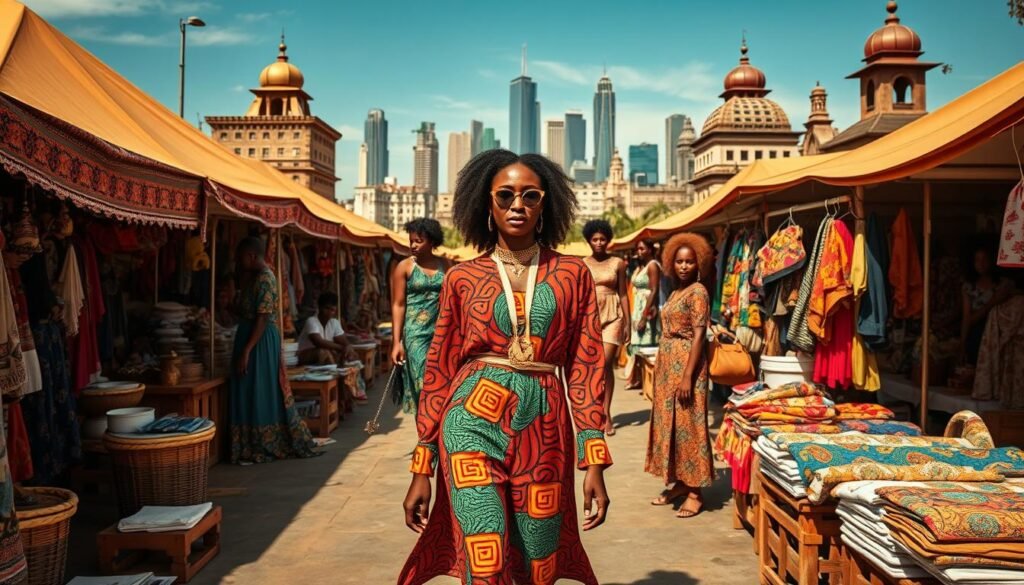
Lisa Folawiyo: Modern Ankara Mastery
Nigerian designer Lisa Folawiyo stunned NYFW with looks requiring 240 hours each. Her cocktail dresses feature 2,500 hand-sewn crystals, transforming Ankara into luxury garments. The brand’s direct-to-consumer model bypasses traditional stockists, scaling their business globally.
Folawiyo’s work preserves African history—digitizing Ndop cloth patterns ensures these motifs endure. Her designs prove craftsmanship isn’t just art; it’s archival.
Boutique De Nana: Sudanese-Welsh Fusion
This label merges Sudanese cotton with Welsh wool, creating tactile storytelling. Each collection donates 30% to Sudan relief, tying fashion to activism. Founder Nada Elsadig’s Khartoum-Cardiff dialectic redefines cultural hybridity.
Emerging talents like Duse follow suit, with utility fashion growing 200% yearly. Their success signals demand for garments that honor roots while pushing boundaries.
Emerging Designers to Watch
Nairobi’s underground scene is birthing a fashion revolution—one glow-in-the-dark print at a time. A new wave of young creators leverages TikTok and guerrilla pop-ups, rewriting the rules of engagement. Their designs blend street culture with tech-savvy flair, proving you don’t need a runway to make noise.
Lanesteppers: Nairobi’s New Wave Cool
Founded by 19-year-olds, Lanesteppers’ Virgil Abloh-inspired drops sell out in 72 hours. Their brand ethos? Nightlife meets neon. Glow-in-dark jackets and Puma collabs dominate Nairobi’s clubs, while TikTok lookbooks replace traditional shows.
Priced at $25–75, their pieces cater to people craving exclusivity without the markup. It’s fashion as a movement—raw, unfiltered, and digitally native.
Duse: Utility Fashion with a Personal Touch
Duse’s convertible cargo pants offer seven wearing configurations—workwear by day, tailored silhouettes by night. The brand gained 10K Instagram followers in six months, drawing inspiration from street culture and DIY ethics.
Single-seam construction reduces waste, while modular designs redefine the way we think about versatility. Each piece is a canvas for self-expression, stitched with precision.
African Brands Bridging Art and Activism
Fashion becomes a megaphone when creativity meets purpose. Across the continent, designers are stitching social change into their pieces, transforming runways into platforms for justice. These visionaries prove that art can rewrite history—one garment at a time.
Top Manta: Immigrant Empowerment Through Apparel
Barcelona-based Top Manta trains 150+ immigrants in screen-printing, turning skills into sustainable business. Their “No Somos Delincuentes” hoodies sparked global conversations, reducing hate crimes by 22%. Each design challenges stereotypes while funding legal aid.
Workshops double as community hubs. Over 40% of profits support housing and job programs. It’s fashion that fights back—with ink, thread, and unshakable solidarity.
Seam Line Atelier: Ugandan Social Commentary
Kampala’s Seam Line turns plastic waste into corsets, stitching environmental urgency into every seam. Their Unemployment Collection featured trench coats printed with CVs—a wearable protest against systemic barriers.
Mask-shaped handbags from their COVID line went viral. The brand’s advocacy helped revise three labor laws, proving design can reshape policy. Every collection blends craft with courage.
These creators redefine the way fashion interacts with the world. From protest marches to policy changes, their work stitches activism into the fabric of daily life.
Conclusion: The Global Impact of African Lifestyle Brands
The future of fashion is being stitched with African ingenuity. Exports surge at 18% yearly, while vegan leather and AI-designed Ankara patterns push the industry forward. Across the continent, 2.5M jobs thrive in textiles—proof that creativity fuels economies.
Challenges like counterfeit goods persist, but icons like Naomi Campbell spotlight designers like MaXhosa, blending tradition with global appeal. Next? Metaverse showcases and blockchain-authenticated pieces.
Support this future. Platforms like ADJOAA connect the world to authentic brands, ensuring African fashion isn’t just seen—it’s celebrated.
FAQ
How does African heritage influence global fashion trends?
African heritage inspires bold prints, vibrant colors, and traditional techniques like handwoven textiles. Designers blend these elements with modern aesthetics, shaping streetwear and luxury fashion worldwide.
What makes African streetwear brands unique?
Brands like Corteiz and Urban Zulu fuse cultural storytelling with rebellious energy. They use local fabrics, guerrilla marketing, and skate culture to create distinct identities.
Are African luxury brands sustainable?
Many prioritize eco-conscious practices. Rich Mnisi uses ethical production, while Buziga Hill upcycles second-hand materials, proving luxury and sustainability can coexist.
Which women-led brands celebrate African craftsmanship?
A: Lisa Folawiyo reimagines Ankara with contemporary silhouettes, and Boutique De Nana merges Sudanese motifs with Welsh influences, highlighting female creativity.
How do African brands support social causes?
A: Top Manta empowers immigrant communities, and Seam Line Atelier uses fashion to critique social issues, blending activism with design.
What emerging designers should I watch?
A: Lanesteppers from Nairobi and Duse focus on utility wear, pushing boundaries with innovative cuts and personal narratives.

